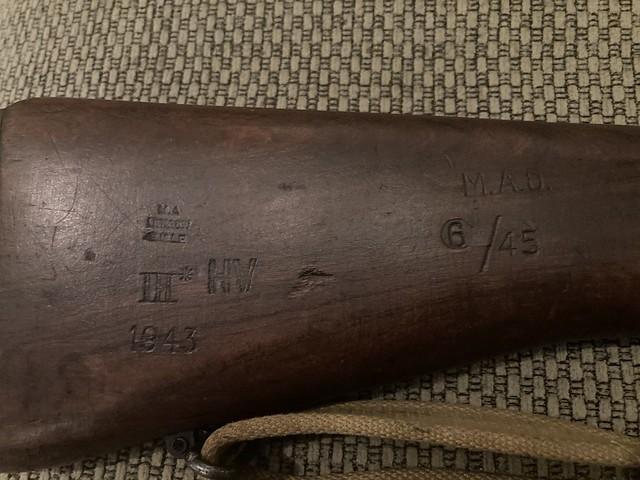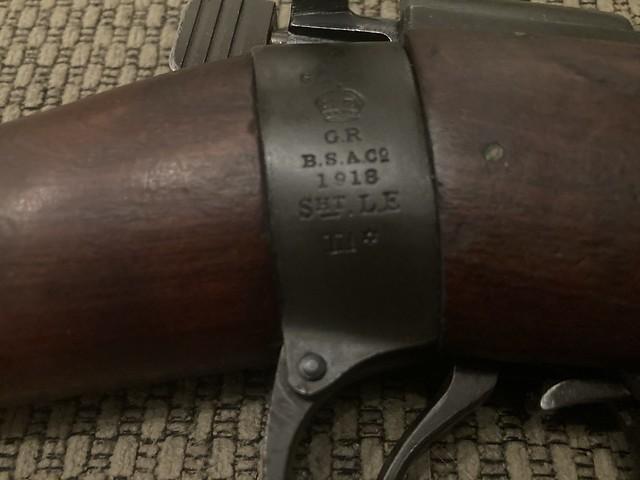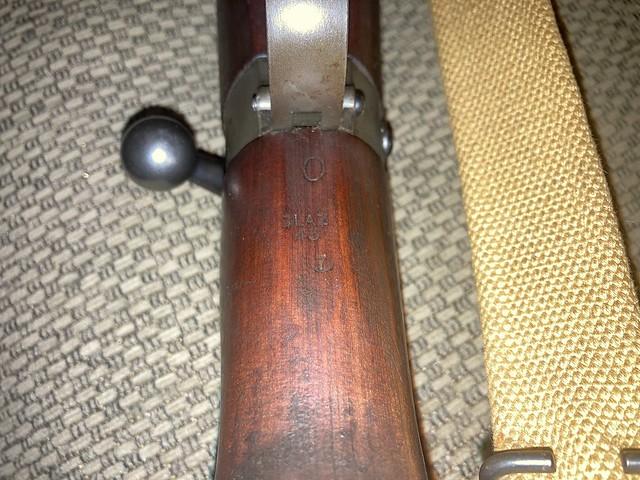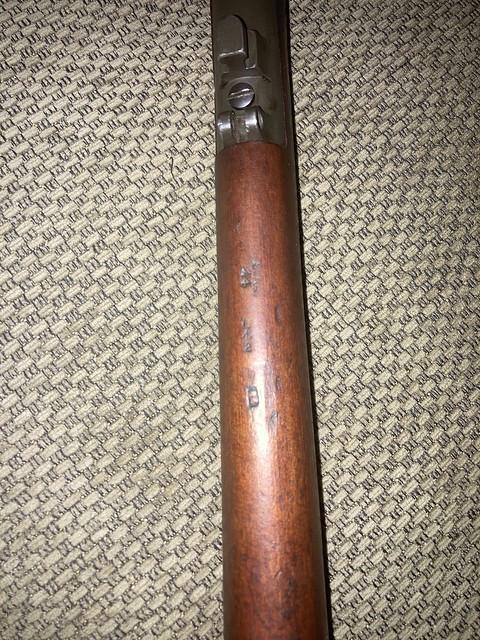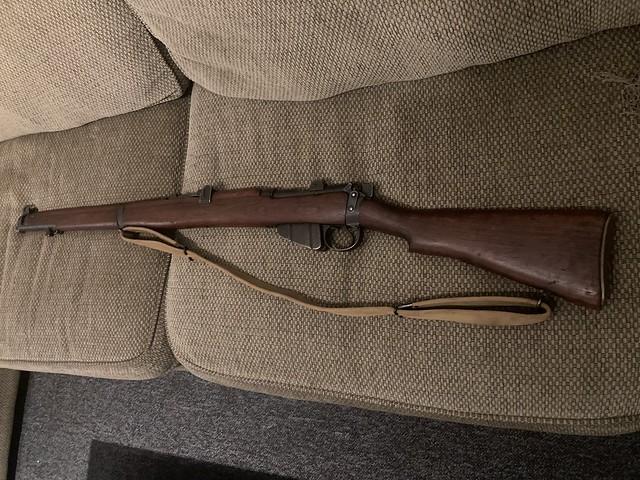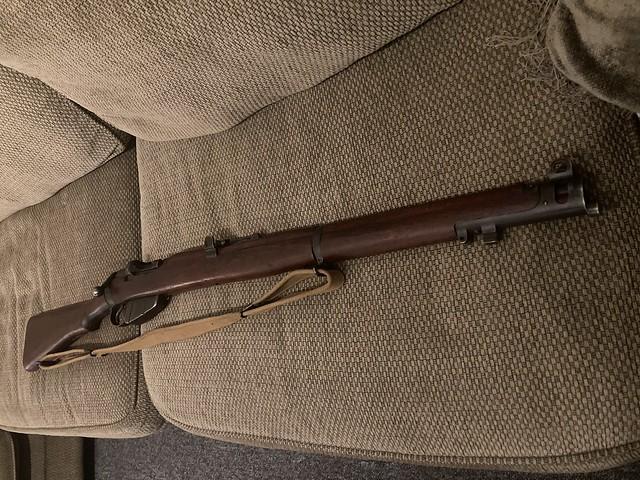-
Contributing Member


Australian FTR’d Enfield Question.
I just received an interesting SMLE No1 MkIII*.
1918 BSA that appears to have been FTR’d in Australia in 1943 and 1945.
in 1943 and 1945.
The stock is marked MA Lithgow 1943 and MAO 6/45.
All if the wood furniture is Slazengers marked with dates from 1942-1945.
Serial number is stamped in the stock.
The bolt and receiver are BSA and matching.
The cocking piece has been replaced and is OA marked (Orange).
The bolt head has been replaced and is BA marked (Bathurst).
The nose guard is BSA but not numbered.
The barrel is OA and dated 6 ‘45 but wasn’t stamped with the serial.
Swivel band and trigger guard are MA stamped (Lithgow).
Magazine is OA marked.
There are BSA and GR proof stamps on the receiver and numerous Lithgow and Orange proof stamps on the barrel and remaining components.
I have read about the Orange arsenal but have never seen anything from there. Nice to have a rifle that appears to have had its final FTR there using a number of components made there.
Any significance or are “Orange” rifles and parts still common?
Information
 |
Warning: This is a relatively older thread
This discussion is older than 360 days. Some information contained in it may no longer be current. |
|
Last edited by Thunderstreak; 07-09-2023 at 07:52 AM.
-
-
07-08-2023 08:58 AM
# ADS
Friends and Sponsors

-
Legacy Member

Orange and. Bathurst where feeder manufacturing plants when they ramped up making more rifles .all are about the same distance from sydney .

Originally Posted by
Thunderstreak

I just received an interesting SMLE No1 MkIII*.
1918 BSA that appears to have been FTR’d in
Australia
in 1943 and 1945.
The stock is marked MA Lithgow 1943 and MAO 6/45.
All if the wood furniture is Slazengers marked with dates from 1942-1945.
Serial number is stamped in the stock.
The bolt and receiver are BSA and matching.
The cocking piece has been replaced and is OA marked (Orange).
The bolt head has been replaced and is BA marked (Bathurst).
The nose guard is BSA but not numbered.
The barrel is OA and dated 6 ‘45 but wasn’t stamped with the serial.
Swivel band and trigger guard are MA stamped (Lithgow).
Magazine is OA marked.
There are BSA and GR proof stamps on the receiver and numerous Lithgow and Orange proof stamps on the barrel and remaining components.
I have read about the Orange arsenal but have never seen anything from there. Nice to have a rifle that appears to have had its final FTR there using a number of components made there.
Any significance or are “Orange” rifles and parts still common?
-
-
Legacy Member

That rifle sounds like it may have been one of the returned replacement rifles lent to G B at the beginning of WW1. Or a bring back by the Aussie army from the war.
Which ever it was it was in bad shape to be left that long before it was FTRd
-
-
Legacy Member

Yeah guys look the commmonwealty troops didn’t start out with aussie rifles at first a lot where British issued rifles and when they got manufacturing up and running they made it to aussie troops ie 1915 .our early 1913 and 1914 lithgows needed up spread out amongst the commonwealth troops . I have 3 1914 lithgows and they all ended up in different service first one ended up being FTRed in india 1932 they didn’t scrub the receiver and kept the original serial number 3780 on all parts they added to it , then i have 5669 that needed up in british service and had various updates up until 1936 then probably was issued out during ww2 to English forces the third one stayed with aussies and post Ww 2 ended up in Austrian police force . I have several 1915 and 1916s that have a mix of ma/oa/ba parts on them either screws sights and trigger parts all ftred in the 1950s .
issued rifles and when they got manufacturing up and running they made it to aussie troops ie 1915 .our early 1913 and 1914 lithgows needed up spread out amongst the commonwealth troops . I have 3 1914 lithgows and they all ended up in different service first one ended up being FTRed in india 1932 they didn’t scrub the receiver and kept the original serial number 3780 on all parts they added to it , then i have 5669 that needed up in british service and had various updates up until 1936 then probably was issued out during ww2 to English forces the third one stayed with aussies and post Ww 2 ended up in Austrian police force . I have several 1915 and 1916s that have a mix of ma/oa/ba parts on them either screws sights and trigger parts all ftred in the 1950s .
-
-
Contributing Member


I have a 1917 BSA No1 mkIII* that has D Broad Arrow D Australian markings and was FTR’d by Lithgow in 1957 with a new barrel and Slaz Coachwood. The bolt is BSA and the nose cap and stock, etc are stamped with the serial. It has OA and MA parts here and there. Sounds similar to your rifle, Thunderstreak.
markings and was FTR’d by Lithgow in 1957 with a new barrel and Slaz Coachwood. The bolt is BSA and the nose cap and stock, etc are stamped with the serial. It has OA and MA parts here and there. Sounds similar to your rifle, Thunderstreak.
-
Thank You to CoatiMundi For This Useful Post:
-
Contributing Member


I haven’t taken this rifle apart yet but strangely, I don’t see a D Broad Arrow D marking on it. Wonder why that was not done, unless it’s hidden under the stock somewhere.
-
-
Contributing Member


Here are the receiver markings on my BSA. The D Broad Arrow D and the FTR are very prominently displayed.
Multiple inspector's marks on the stock but no serial number. The nosecap is a Bathurst but was marked with the original serial. The trigger guard is an Orange.
I was mistaken, it is a 1918 not a 1917.
-
Thank You to CoatiMundi For This Useful Post:
-
Contributing Member


-
-
Contributing Member


Very similar, although FTR’d quite awhile apart!
I believe they didn’t start marking FTR on the receivers until after WWII. I’m sure someone more qualified than me can verify that. 
-
Thank You to CoatiMundi For This Useful Post:
-
Legacy Member

I believe the first use of the FTR mark at Lithgow was in 1950. Prior to that, refurbished rifles usually had the moth and year stamped into the butt. Example R over MA over 7/45 for a rifle refurbished in July 1945. Placement of the serial number on the barrel and rear sight had been omitted in Australian production by 1945, even on new rifles. A lot of refurbished rifles will be void of serial numbers except for the bolt and receiver. The MAO stamp relates to Orange (name of the town) production. The plant at Orange was originally set up as a feeder factory for parts however new rifle production/assembly was moved there during WWII and didn't move back to the main Lithgow plant until around the end of the war. Might have been just after the war, can't recall the exact year. Most refurbished rifles I've seen have the R over MA and year stamp, indicating repairs at Lithgow. I'm taking a guess that your rifle may have been refurbished at Orange? Someone with more knowledge may chime in to clarify. It's totally normal to find refurbished rifles from English manufacturers as well as a mix of Australian and English parts used during repair. I have 1944 Lithgow SMLE that went through FTR in 1950 where an English barrel was fitted. The barrel was then marked with Lithgow acceptance marks.
production by 1945, even on new rifles. A lot of refurbished rifles will be void of serial numbers except for the bolt and receiver. The MAO stamp relates to Orange (name of the town) production. The plant at Orange was originally set up as a feeder factory for parts however new rifle production/assembly was moved there during WWII and didn't move back to the main Lithgow plant until around the end of the war. Might have been just after the war, can't recall the exact year. Most refurbished rifles I've seen have the R over MA and year stamp, indicating repairs at Lithgow. I'm taking a guess that your rifle may have been refurbished at Orange? Someone with more knowledge may chime in to clarify. It's totally normal to find refurbished rifles from English manufacturers as well as a mix of Australian and English parts used during repair. I have 1944 Lithgow SMLE that went through FTR in 1950 where an English barrel was fitted. The barrel was then marked with Lithgow acceptance marks.
-
The Following 2 Members Say Thank You to BradJ For This Useful Post:
in 1943 and 1945.
















 PM
PM







